Working Principle of Four-Column Hydraulic Press Machine
A four-column hydraulic press machine is a versatile and powerful machine tool that utilizes the principle of Pascal's law to generate high force for various applications, such as metal stamping, forging, and plastic molding. This article explores the working principle of a four-column hydraulic press machine, delving into its key components, operation, and advantages.
Table of contents:
Introduction to four-column hydraulic press
Key components of four-column hydraulic press
Working principle of four-column hydraulic press
Advantages of four-column hydraulic press
Application of four-column hydraulic press
Conclusion
1. Introduction to four-column hydraulic press:
A four-column hydraulic press machine is a machine tool that employs hydraulic pressure to exert a large force on a workpiece. It is characterized by its four columns that guide the movement of the platen, ensuring precise alignment and high stability. This article aims to provide a comprehensive understanding of the working principle of a four-column hydraulic press machine.
2. Key components of four-column hydraulic press:
The main components of the four-column hydraulic press include:
Frame: A strong frame provides structural support to the machine and houses the major components.
Four Uprights: These uprights guide the movement of the platen and ensure precise alignment.
Pressure Plate: A movable part of a machine that applies pressure to the workpiece.
Hydraulic Cylinder: A hydraulic cylinder generates the force required to move the platen. It consists of a piston and a cylinder filled with hydraulic oil.
Pump and control system: The pump supplies pressurized hydraulic oil to the cylinder, and the control system adjusts the flow and pressure of the oil to control the movement of the pressure plate.
3. Working principle of four-column hydraulic press:
The working principle of the four-column hydraulic press is based on Pascal's law, which states that pressure exerted at any point on a confined fluid will be transmitted uniformly to all directions of the entire fluid.
Here's how it works:
The pump draws hydraulic oil from the tank and pressurizes it.
Pressurized oil is directed to the hydraulic cylinder.
The oil enters the cylinder and pushes the piston connected to the pressure plate.
The pressure plate moves downward, exerting pressure on the workpiece.
The pressure can be adjusted by controlling the flow and pressure of hydraulic oil.
Once the desired pressure is reached, the pump can be turned off and the pressure plate will remain in place.
After the work is completed, the oil is released from the oil cylinder and the pressure plate returns to its original position.

4. Advantages of four-column hydraulic press:
Four-column hydraulic presses offer several advantages over other types of presses, including:
High Force: They can generate large amounts of force with a relatively small footprint.
Precise control: The pressure and speed of the plate can be precisely controlled.
Versatility: They can be used in a wide range of applications.
Reliability: They are rugged machines that can withstand heavy use.
Safety: They are equipped with safety features to prevent accidents.
5. Application of four-column hydraulic press:
Four-column hydraulic presses are used in a variety of industries, including:
Automotive: Used to stamp metal parts for cars and trucks.
Aerospace: Used to manufacture aircraft components.
Construction: Used to shape metal beams and columns.
Electronic products: used to assemble electronic components.
Plastic Molding: Used to make plastic products.
Metalworking: For forging, stamping, and bending sheet metal.
Food processing: used to press and package food.
Recycling: Used to compact recyclable materials.

6. Conclusion:
The working principle of the four-column hydraulic press is to use Pascal's principle to generate huge pressure.
The characteristics of the four-column hydraulic press are simple structure, convenient operation, stable pressure, and wide application range.
Four-column hydraulic presses have a wide range of applications and are mainly used in automobile manufacturing, aerospace, construction, electronic component manufacturing, plastic product manufacturing, metal processing, food processing, waste recycling and other industries.
Four-column hydraulic press is an indispensable and important equipment in modern industrial production.





